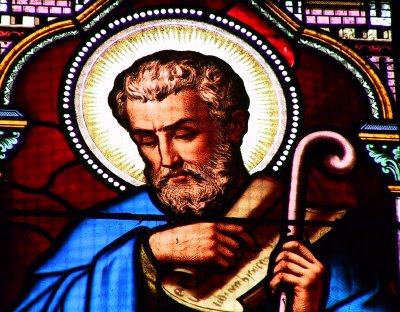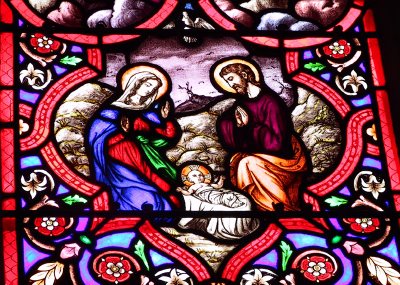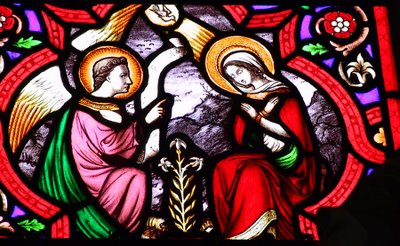Looking through the Michelin Green Guide for the Berry and Limousin provinces, I came across a page describing the village of Palluau-sur-Indre. If you know French, you can see that Palluau is an unusual name, and that alone intrigued me. The Green Guide says Palluau is a "charmante petite ville" with a château and church at the top of a hill and houses that step up the hill from the river valley. It sounded interesting to me, so we started there.

Well, in Palluau right now all the streets are torn up for repaving. We kept coming to ROUTE BARRÉE signs and having to sit and wait while heavy equipment blocked up the roads. Finally we found a way to drive around back of the village and arrived at the church. We parked in front of the tourist office. The château was on a steep hill — a cliff, really — just above us.
An interesting side note: Palluau was the home town of Louis de Buade de Frontenac, who was governor of New France (Quebec) in the late 1600s. The hotel called the Château Frontenac in Quebec City is named for him. Frontenac was the comte de Palluau.

The tourist office was closed, but an older couple inside noticed us and invited us to come on in anyway. They were very nice but told us we had come to Palluau on a bad day. The village is under contruction, and the château is closed until July 1, they said. Please come back in July. We ended up visiting the church and walking up and down the one street that was not being repaved. We took some pictures and moved on. As you can see, I took a lot of pictures of stained-glass windows in churches over the course of the day.

Just across the Indre river from Palluau is a little town called Saint-Genou. That means Saint Knee in English (I'm sure Genou was a fine name long before it came to mean knee). We drove over there. The entry to the town was a road at least half a mile long that was lined with big trees, in typical French fashion. It was beautiful.

Saint-Genou was the site of an ancient Benedictine abbey, of which just a small part of a church remains. The abbey was founded in 828, according to the Green Guide, and later was named in honor of the saint named Genou, who had been sent to Gaul by the pope to convert the natives to Christianity.

I like this sentence in the Green Guide, describing Saint-Genou: "Commencée en 994, la nouvelle église fut consacrée en 1066 ; son déclin s'amorça en 1516." Begun in 994, the new church was consacrated in 1066. 1066! And that was the new church. Its decline began in 1516. Well, it had about a five-century run, and that's not too shabby. It's a gorgeous old church.

After our quick, unplanned stop in Saint-Genou, we drove on through the bigger town of Buzançais (not mentioned in the Green Guide) and then to the town of Levroux, where there is a gothic church. The name Levroux derives from the same root as the word leprosy, and the town got that name because Saint Martin cured a local notable of the disease in the 400s. Levroux has existed as a settlement since prehistoric times, and archological digs have turned up significant Roman ruins there.

We couldn't find a good spot for our picnic in Levroux, but in the window of the tourist office there we saw an aerial photo of a great-looking château in the neaby village of Villegongis (don't you just love all these names?). We headed that way, thinking we would surely find a picnic table out in the country or on the grounds of the château. Unfortunately, the château grounds were closed to the public "exceptionnellement" because crews were cleaning up tree limbs that had fallen during recent windstorms. We didn't get to see the château or have our picnic there.

We drove on to another village called Chézelles and did find a picnic spot there, though sans table. We made our sandwiches on a little park bench near a playground behind the village hall, and sat on the ground to eat them.
 After shopping successfully at Carrefour and Leroy-Merlin in Châteauroux, we drove back home through the towns/villages of Coings (un coin appelé Coings, pas mal !), Bretagne (there was a picnic table there -- next time), Bouges-le-Château, Veuil (another château), and Villentrois (yet another). It was yet another fine day.
After shopping successfully at Carrefour and Leroy-Merlin in Châteauroux, we drove back home through the towns/villages of Coings (un coin appelé Coings, pas mal !), Bretagne (there was a picnic table there -- next time), Bouges-le-Château, Veuil (another château), and Villentrois (yet another). It was yet another fine day.


Ken--Loved the pics of the stained glass. I am transfixed with your blog--both photos and text. Keep up the wonderful job.
ReplyDeleteBeautiful series of stained glass photos. But I'm sorry you had to go to Châteauroux.
ReplyDeleteGlenda, thanks for the nice words. I enjoy doing the blog and am glad when people enjoy reading it.
ReplyDeleteBC, we didn't absolutely HAVE to go to Châteauroux. But if we want to shop in a hypermarket, we have three choices: Tours, one hour away; Blois, 45 minutes away; and Châteauroux, 45 minutes away. In Blois there is no Leroy-Merlin store. So "pour varier les plaisirs" -- for a change from Tours (been there, done that many times) -- this time we decided to go to Châteauroux, which doesn't have an awful lot to recommend it. But the country north and west of the city is just beautiful.
I was born in Issoudun, where my parents took me back once when I was about ten years old. But that is in the Berry, and I always thought I should go and have a look some time.
ReplyDeleteI too enjoyed the gorgeous stained glass photos!
Claude, I haven't yet been to see Issoudun and have been talking about going there for a couple of years now. Maybe the opportunity is about to present itself...
ReplyDelete